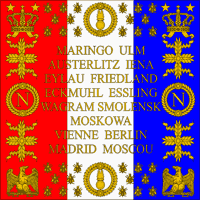Battle Honor
Battle Honor are a tradition of the Commonwealth -Staaten United Kingdom , Australia , Canada and New Zealand . There are honorable mentions of battles in which a part of the troops successfully participated. The battle honor is conferred by the monarch in his capacity as head of state.
history
Great Britain
Battle honors are awarded to regiments and battalions in the army and to ships and squadrons in the other armed forces. Lending to smaller units only takes place in exceptional cases. Combat support units such as B. Engineer, artillery and supply units cannot receive battle honors, however units of the first two categories have the Latin word ubique (meaning everywhere) in their coat of arms instead.
Battle honors are given in the form of the names of the campaigns or battles in which the unit excelled, sometimes combined with the year. They are partially listed in chronological order on the regimental flag and the drums of the regimental band. More rarely, individual battle honors are shown in the regimental coat of arms or on the effects of the uniform (e.g. buttons, emplems on collars and headgear). For example, some British regiments wear a sphinx for their participation in the battle of Tel-el-Kebir in the campaign to suppress the Urabi movement in Egypt . The Royal Scots Dragoon Guards continue the tradition of the Scots Grays , who distinguished themselves in the Battle of Waterloo , and carry the word Waterloo in the badge.
In view of the often very long traditions of British army units , which continue the traditions of the previous units even when regiments are amalgamated, the battle honors have a special meaning. They show all soldiers of the unit, but especially the recruits , in which tradition they belong.
The first battle honors were awarded towards the end of the 18th century. At the end of the 19th century, the award was formalized through the establishment of an award committee. It is not uncommon for the award to take place decades after the event, so that sometimes the award no longer appears on the flag of the awarded regiment, but on that of its successor regiment, which was created through amalgamation.
France

Napoleon decreed that the names of victories in which the regiment participated should be listed on the back of the regimental flags of his army. The award was made to all regiments involved, so that, for reasons of space, the award was restricted in such a way that only victories won under the personal command of the emperor were shown on the flags. With the restoration, all references to the empire and republic were initially erased from the flags, but with the July Revolution of 1830 and the reintroduction of the tricolor also for troop flags , these awards were renewed and have been retained to this day.
Germany
In Germany , until the Second World War, the flag ribbon was an award similar to the Battle Honor, which could be awarded for participation in certain battles or campaigns, albeit to a lesser extent. Since the Bundeswehr does not maintain any specific traditions of units of its predecessor armies, these awards were not adopted. Some units of the Kingdom of Hanover , which had emerged from the British King's German Legion , conducted battle honors based on the British model. After the annexation of Hanover by Prussia, this tradition was at least partially continued with uniform parts, for example the Tschapka fitting from the Königs-Ulanen-Regiment (1st Hannoversches) No. 13 wore a foreign exchange ribbon with the inscription: PENINSULA - WATERLOO - GARZIA-HERNANDEZ.
Web links
- Battle Honors , website of the Ministry of Defense
- A list of British, Imperial and Commonwealth battle honors , website of regiments.org
- Canada's Battle Honors , Legion Magazine
- Canadian Army Battle Honors
- Battle Honors of the Royal Canadian Armored Corps
- Battle Honors of the Royal Canadian Infantry Corps
- Battle Honors of the Royal Navy, 1939-1945
